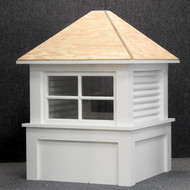Shed Cupolas: History,Origin and Evolution
Posted by Todd on Nov 20th 2023
Architectural trends come and go, but shed cupolas are here to stay. They are a charming addition to any structure and perform important functions. Read on to learn about its history and origin and how they are important to homes and sheds.
Shed cupolas can be dated back to the 8th century in the Middle East. They soon spread to Russia and Italy, where they got their name. The word 'cupola' is Italian and comes from the Latin word 'cupula,' meaning a little tub. Cupolas got this name since they look like small tubs sitting upside down on the roof. The earliest ones were placed atop minarets in the Middle East.
Early cupolas were crucial to the architectural world since they were believed to be the inspiration for the dome, which later led to breakthroughs in architecture and design. This idea of the cupola eventually spread across Europe, becoming an artistic and creative status symbol placed atop government buildings and homes of royalty.
Cupolas have always been used to identify important town buildings, hold bells, circulate air, be lookout spots, and provide more natural light. By the end of the 1600s, shed cupolas had spread throughout Europe and eventually found popularity in the US. Today, they can be found in houses, sheds, garages, barns, schools, town buildings, and gazebos.
Ventilation and light were the major functions of a cupola in the past. Farmers also used them due to their ability to circulate air and light into their barns. They would keep the barn air moving to reduce hot air, lingering smells, and stuffiness. So, along with their decorative charm, they were also used for many important functions.
Shed cupolas were designed to keep rain and bad weather out while still providing proper ventilation and natural light. This allowed the farmers to keep the air in their barns fresh in the winter without opening any doors.
Historically, cupolas were varied and plentiful structures. Large cupolas were accessible via an interior stairway, giving the climber a beautiful vantage point to look out over their surroundings. Such cupolas were called widow's walk or belvedere. Smaller cupolas were designed to provide an extra light source to illuminate the space and were known as lanterns.
Cupolas Today
Adding a cupola to homes, sheds, barns, and garages today gives an extra architectural detail that completes the structure's look while also adding a personal touch. Shed cupolas come in many colors, sizes, designs, and styles, so they easily blend with the building's exterior. One can also add weathervanes to enhance the look of the building and get an insight into the weather and wind direction.
Cupolas can be customized to match the rest of the house through materials, colors, and architectural styles. There are numerous options to choose from; hence, you can find a cupola within your budget. Placing a cool can also change the look of your building or shed. Therefore, its installation requires great care.
Final Thoughts
So, if you think your shed, garage, or house is missing something, a cupola may be just what you need. You can look for high-quality cupolas that can give your home an added country charm.
Featured Image Source: https://cdn11.bigcommerce.com/s-w8g2lva4p6/images/stencil/640w/products/2203/7776/cupolacrawford3176__82236.1678280967.jpg?c=1
